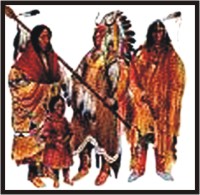People & Places
'A' For Apache
Compiled by Efadul Huq
 Confession of a historian Confession of a historian
The primitive Apache was a true nomad, a wandering child of Nature, whose birthright was a craving for the warpath with courage and endurance probably exceeded by no other people and with cunning beyond reckoning.
Ambiguous theories of their origin
The word "apache" comes from the Yuma word for "fighting-men" and from the Zuni word meaning "enemy." The Anglo theory is, the Apache Indian migrated to the Southwest from Northern Canada in the 1500's. The Apache Indian history says it was the other way around, that most of the Athapaskan speaking people migrated to the North and a few stayed in their homeland. In any event, it is generally agreed that about 5,000 Apaches lived in the Southwest at the end of the 1600's.
The way they were ruled
Chiricahua was the informal political unit, consisting of followers and a headman. They had no formal leader such as a tribal chief, or a council, nor a decision making process. The core of the band was a "relative group," predominantly, but not necessarily, kinsmen.
In clash with the Spaniards
Though limited to using dogs as pack animals, the Apache were the most successful raiders. When the Spaniards brought horses once again to North America (the previous horses had been eaten long before) the Apache took full advantage. Their contacts with the Spaniards began with Coronado in 1540 to 1542. Hostilities began almost at first contact with the Spaniards.
Of citizens and basic necessities
The primitive dress of the men was deerskin shirt, leggings, moccasins and they were never without a loin-cloth. A deerskin cap with attractive symbolic ornamentation was worn. The women wore short deerskin skirts and high boot top moccasins. The Apache dwellings consisted of a dome shaped frame of cottonwood or other poles, thatched with grass. The house itself was termed, "Kowa" and the grass thatch, "Pi".
 All Apache relied primarily on hunting of wild game and gathering of cactus fruits. Apache hunted deer, wild turkeys, jackrabbits, coyote, javelin, fox, beavers, buffalo, bears and mountain lions. There was no fishing! They were strictly non-fisheatereans! Apache boys were schooled to move quickly and quietly through the forest to catch food. The first thing an Apache male did before hunting was greasing his body with animal fat to make himself smell like an animal so the animals wouldn't smell him as a person and run away. All Apache relied primarily on hunting of wild game and gathering of cactus fruits. Apache hunted deer, wild turkeys, jackrabbits, coyote, javelin, fox, beavers, buffalo, bears and mountain lions. There was no fishing! They were strictly non-fisheatereans! Apache boys were schooled to move quickly and quietly through the forest to catch food. The first thing an Apache male did before hunting was greasing his body with animal fat to make himself smell like an animal so the animals wouldn't smell him as a person and run away.
Symbols, dances and beliefs
Their ceremonies are invariably called "dances." Among these were the rain dance, a puberty right, the sunrise dance for young women, a harvest and good crop dance, and a spirit dance. The sunrise dance taught Apache values of language, culture, food, love, prayers, respect, wisdom, cooperation, appreciation and endurance. The Apache were devoutly religious and prayed on many occasions and in various ways. They believed, recreated in the human form, Apache spirits dwelled in a land of peace and plenty, where there is neither disease nor death. In the early 1900s, when the U.S. government banned Native American spiritual practices and rituals, conducting the Sunrise Ceremony was an illegal act; as a result, its practice diminished, and those ceremonies that did occur were conducted secretly.
Not until 1978, when the American Indian Religious Freedom Act was passed, was the Sunrise Ceremony re-established. But even today, because of the expense and time involved - which also includes four days of preparation and four days of teaching and recovery - some girls celebrate for one or two days, rather than having a four day ceremony.
Circle was a very important symbol for the Apaches; the circle represented the cycle of life from birth to death. They believed the circle also had healing and protective powers. The four sacred colors of the tribe: black, green, yellow and white represented the four directions, the four seasons, and the four major divisions of the day.
|
